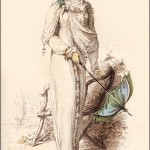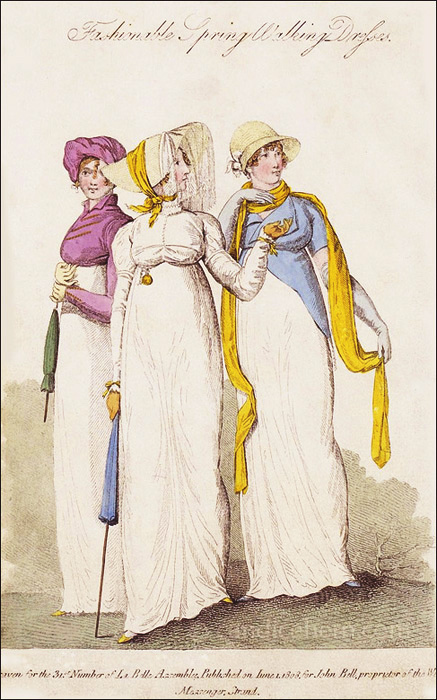Gallery of Fashion, July 1795.
“Morning Dresses”
These are outdoor morning dress, ie morning walking dresses. Though waistlines at this time have risen quite high, there is still a fullness in the skirts that harkens back to the previous decade. Hairdos, hats, plumes, and feathers also still suggest the heights of earlier years, though styles will change quickly in the next 2-3 years when hair and hats are worn closer to the head.
The popularity of white muslin dresses began in the late 1780s when the artist Élisabeth Louise Vigée Le Brun depicted the stylish Marie Antoinette in a plain white muslin dress. That simple white dress, worn by a queen, was something of a scandal. Not only was the simplicity of the dress unlike the lavishly beaded and embroidered and colorful gowns then in style, but it was also made of a semi-transparent cloth that could be somewhat revealing. The white muslin gown was soon adopted by the more “fast” ladies of the beau monde who shocked polite society with filmy gowns that hugged the figure. By the time of this print, 1795, the white muslin gown was worn everywhere by everyone, and would continue to be so throughout the Regency period, getting less and then more full over the years, and keeping laundresses busy.
The print is described in the magazine as follows:
“Fig. LX. The hair frizzed into light curls; the hind hair turned up plain. Nuns bonnet of lilac taffeta, the cawl of green taffeta, trimmed with white blond and lilac ribands. Brunswick frock of clear lawn, with five tucks at the bottom. Short loose sleeves, trimmed with lace, and tied in the middle with a narrow lilac riband. Full plaiting of broad lace round the neck. Sash of green riband. Gold ear-rings. Lilac gloves. Yellow shoes.
“Fig. LXI. The hair in light curls and ringlets. Straw hat, trimmed with straw band, feathers, and tassels. Round gown of embroidered muslin, flounced at the bottom. Short full sleeves, drawn in the middle of the arm. Body of lilac taffeta. Yellow handkerchirf, crossed in the front, and tied behind. Gold ear-rings. Grey gloves and shoes.
“Fig. LXII. The hair in light curls; the hind hair in ringlets. Hat made of white silk and straw, trimmed with variegated ribands, White ostrich feather placed on the left side. Veil of white clear lawn. Round gown of clear lawn embroidered at the bottom; short sleeves, trimmed with the same. Black spotted gauze cloak, cut our for the arms; the hind part square, tied to the waist with a riband, and the whole trimmed with a broad lace. Buff gloves. Green and purple striped shoes.”
Don’t you wish we could see the “green and purple striped shoes” on the right figure? I suspect they would look something like this.









